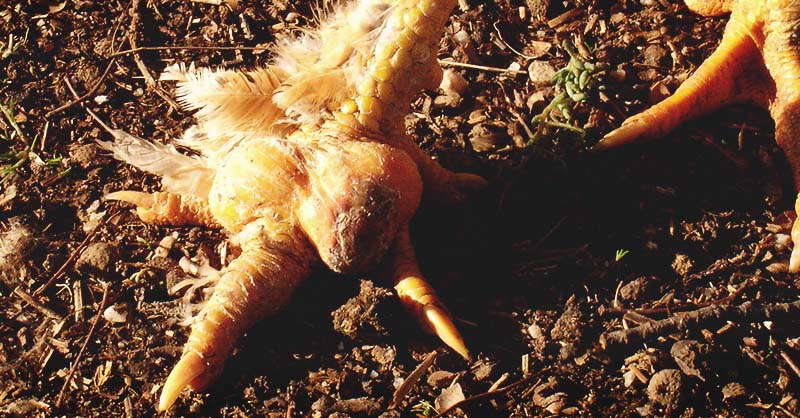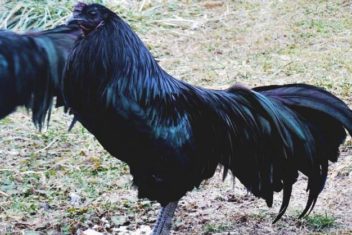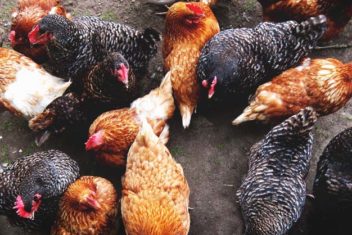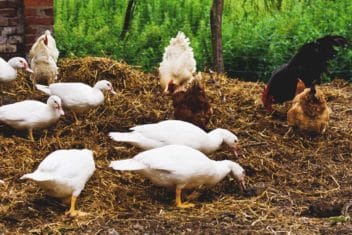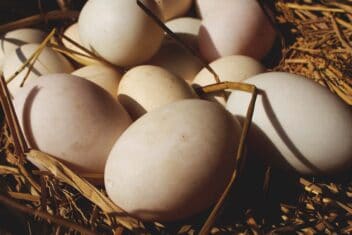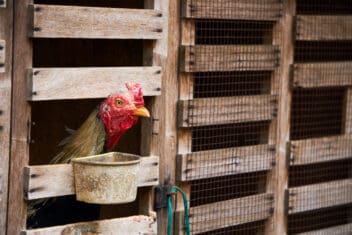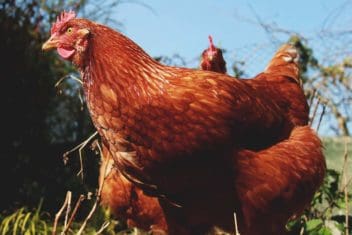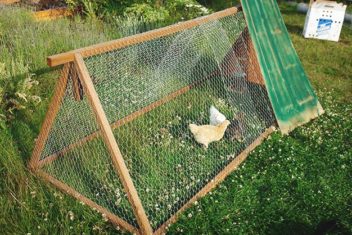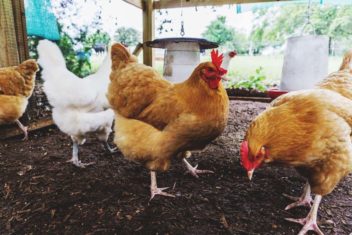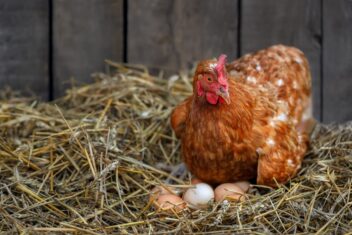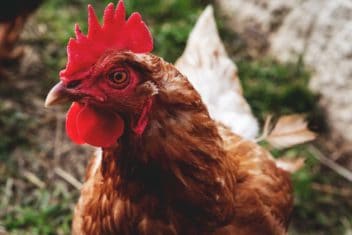The first time you see your backyard bird limping, you might assume it merely has stubbed its toe. But as the days go by, it becomes clear that the affliction is not getting better, and in fact, your bird’s health seems to be going downhill.
A quick internet search will tell you that your beloved bird probably has bumblefoot.
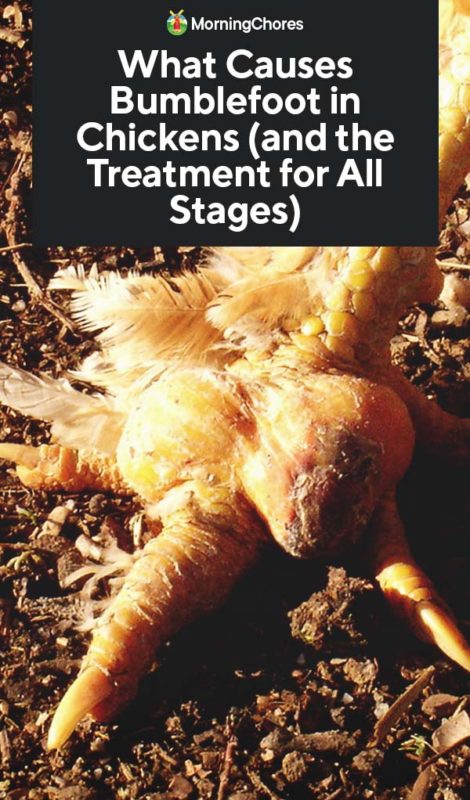
What is Bumblefoot?
Bumblefoot is a nasty bacterial infection that enters your poultry’s foot through a wound, sets up shop, and ends up causing a slow, painful death if it is not treated.
An initial injury with an open wound provides an entry point for bacteria. Bacteria are found everywhere, from droppings from other members of the flock, other animals on your property, or in any other kind of unclean element.
Bumblefoot can be treated if caught early; however, the fact that the injury is on the foot of your chicken, makes treatment difficult.
The medical name for bumblefoot is Ulcerative Pododermatitis, which generally speaking, means an ulcerative inflamed infection of the foot. This beast of an infection can lead to systemic infections of the bones and tissues of the rest of the chicken, and eventually, the bird will become too weak and sick to survive.
Many people think of chickens when they think of bumblefoot, but in truth, other types of birds can contract this bacterial infection. Guinea hens, ducks, penguins, and birds of prey can all get bumblefoot.
Surprisingly, other animals can also contract different types of bumblefoot; however, it is usually referred to as sore hocks, according to PetMdD. Sore hocks are often caused by animals living in small spaces, typically due to poor hygiene.
How Do Chickens Get Bumblefoot?
Bumblefoot in poultry is often caused by a staph infection that develops in an open wound on their feet. Sometimes a small cut on your chicken’s foot from scratching and foraging is enough to invite infection into the body.
A dirty coop creates a prime condition for the growth of harmful bacteria that leads to this disease.
In addition to small cuts caused by everyday wear and tear, there are a few causes of injury that you may be able to prevent:
1. Messy Environment
If you’ve got a lot of stuff lying around like tacks, nails, broken glass or sharp metal objects, your chickens can easily puncture the bottom of their feet. Ensuring your poultry have a safe, clutter-free environment is just one way to prevent an injury that could lead to bumblefoot.
2. Splinters on The Roost
A ratty perch can cause slivers and splinters to get under the skin on a chicken’s rough and tough feet. If you’ve had your roosts set up for a few years, consider doing routine checks. You can ensure that your chickens’ feet aren’t getting spiked by wood splinters every time they roost in the evening.
3. Overuse of Diatomaceous Earth (DE) in The Chicken Coop
Diatomaceous Earth, which is usually used to treat mites and parasites, is a fantastic resource to have on hand. However, if you are too generous while distributing diatomaceous earth, you could dry your chickens’ feet out, and cause cracking.
Bacteria can enter through cracked feet and result in an infection that may lead to bumblefoot. Try to limit diatomaceous earth to your chickens’ favorite dry bath location, so they can access it when they need it.
4. Rough Landings
If you have larger breeds of poultry, repeated heavy landings can cause damage to the bottoms of their feet. Keeping roosts close to the ground can help alleviate the impact.
5. Living in Confinement
Poultry kept in confinement can survive just fine if they have the appropriate amount of space; however, if your birds have to stand in one place for extended periods, the pressure from limited movement can lead to sores. Think of it as being similar to a human’s bedsore: if someone is bedridden, they can get sores on their body due to the pressure of the mattress, or chair, against their skin.
6. Fighting Between Birds
Usually, a pecking order brawl will work itself out pretty quickly. However, if you have two aggressive roosters that engage in a blood bath, their feet can become scratched and punctured.
Spurs can slice through the soft flesh on the bottom of a chicken’s foot, creating an entrance for bacteria from the environment or the other bird’s dirty claws.
Symptoms of Bumblefoot

Luckily, Bumblefoot can be identified early on, before the infection spreads to bones, joints, and tissues. Watch for the following symptoms to determine if your poultry has contracted an infection caused by bumblefoot:
1. Limping
Chickens and other poultry limp from time to time. If they are jumping from high places, they may strain their feet and legs due to the landing. However, if you do see your bird limping, check the bottom of its feet immediately, and look for open wounds.
2. Red Bumps or Sores on Feet
These little bumps will usually be rough and scattered. This kind of bumblefoot is caused by jumping, or walking, on rough or hot surfaces. Usually, this symptom is an early one, and if the conditions that caused the injury can be corrected you can prevent bumblefoot from progressing.
3. Swollen feet
You’ve noticed your bird limping for some time, and one foot appears to be much larger than the other. Swollen feet are the most obvious sign of Bumblefoot and an indication that the infection has spread to other parts of the body.
4. Fatigue
Your bird probably has a few other symptoms that point to bumblefoot, and if you’ve already identified those, and your bird has become weak, listless, and needs to take frequent breaks, it’s probably because of Bumblefoot. In this scenario, the bird’s system is infected and possibly starting to shut down.
5. Decrease in Appetite
Your bird has a great appetite typically, but all of a sudden, it doesn’t seem to be eating or foraging as much as it used to. When the infection starts to spread to other parts of the body, the bird’s appetite will slow down as they don’t feel very well.
6. Plug-like Black Scabs on Bottom of Feet
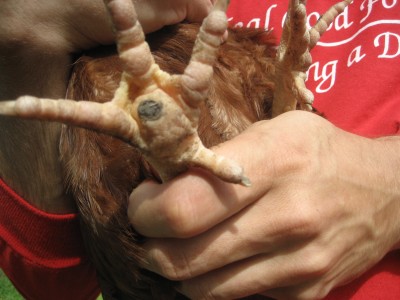
The telltale sign of bumblefoot in poultry is the presence of a blackened plug (or scab) on the bottom of the bird’s feet. This happens when infected cells begin to die, otherwise known as necrotic tissue. At this point, the infection has been around for a while, and it’s safe to assume that it’s spreading to other parts of the body.
Stages and Treatment of Bumblefoot
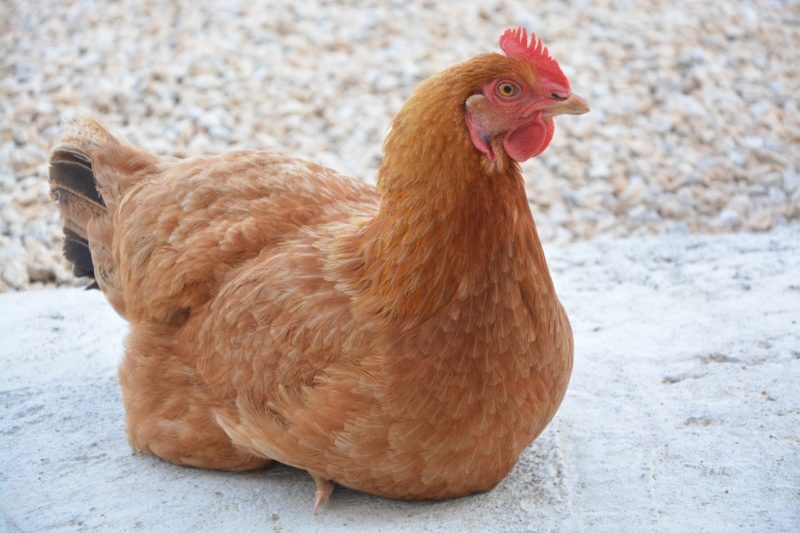
Catching bumblefoot early on is essential if you are hoping to treat the infected bird. Because chickens and poultry use their feet constantly for walking, perching, scratching, fighting, and foraging, a simple wound will not heal on its own. However, there are actions you can take at each stage of the infection that can change the inevitable outcome of Bumblefoot:
Stage 1 of Bumblefoot: The Initial Wound
The first stage of bumblefoot is usually the presence of a wound on the bottom of the bird’s foot. It will be difficult to identify the potential infection in this stage unless you saw the injury occur or you check your chickens’ feet regularly.
If your chicken stepped on something, you might notice limping even before an infection sets in. If you do see signs of pain, get hold of your chicken as soon as possible, and look for wounds.
– What To Do
Soak your chicken’s foot in a warm Epsom salt bath. Restrict perching, activity, and keep the chicken on a soft surface for healing. If the wound is bleeding, you can use cornstarch or blood stop on the wound to help it clot.
Stage 2 of Bumblefoot: The Start of an Infection
During this stage, you will notice that your chicken is clearly limping and in pain. This is the turning point for the infection; it should be addressed now, or it will continue to spread if not treated.
– What To Do
Do everything in stage one and treat the foot with an antibacterial substance, then wrap the foot to keep additional bacteria from entering. Some people use honey on their chicken’s wounds due to the antibacterial properties; however, it isn’t a time to experiment, so go for the big guns like a triple antibiotic ointment.
Stage 3 of Bumblefoot: The Black Plug
If your chicken is showing symptoms of bumblefoot and has not been treated accordingly, the initial wound will have formed a black plug-like scab. This is an ulcer of dead cells and can cause extreme pain for your chicken if it attempts to walk on its foot. If your chicken has a black scab, you are now in the danger zone.
– What To Do
Here’s where things get ugly. You can still attempt to help your chicken if you think the infection is reasonably local. In this stage, you will have to put on a metaphorical surgical gown because you are going to try to remove the black plug, drain the pus, and treat the infection.
Follow the steps in stage one, then use a sanitized scalpel to remove the blackened plug. Do your best to wash the wound, and gently squeeze the pus out of the wound.
Remember, the plug is mostly dead tissue, and once it is softened in the saltwater bath, it can be removed easily with very little cutting involved.
You must wear gloves during this stage because you can contract certain types of staph infections from your chicken’s wound if you are not careful.
If you are lucky, you may have a veterinarian nearby that can do all of this for you, which I highly recommend.
Stage 4 of Bumblefoot: Time to Make a Decision
Stage four is the final stage of bumblefoot. You’ve done everything you can, but the infection is relentless. In this stage, your chicken has a systemic infection, and their organs are slowly dying.
The bird has most likely begun to lay down, not want to move much, and seems to be struggling to live. You may want to consider euthanasia at this point, or you can consult your vet for rigorous treatment options.
Prevention of Bumblefoot in Poultry
Some causes of bumblefoot are preventable; however, bumblefoot can also occur due to things we cannot control, like an overweight hen jumping from a high perch or a nasty fight between two roosters. If you want to do your part to keep bumblefoot at bay, make sure to:
- Keep the coop clean and dry
- Separate roosters
- Ensure a clutter-free environment
- Maintain perches and roosts
- Keep roosts close to the ground
- Keep infected birds separate
- Give birds ample space
- Keep chickens on smooth surfaces
Bumblefoot is a dangerous infection, and once it grabs hold, it can be hard to treat your chicken; however, it can be done at nearly any stage. It is always best to consult a vet, but there are things you can do to help the healing process early.

